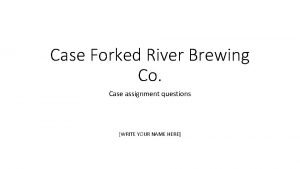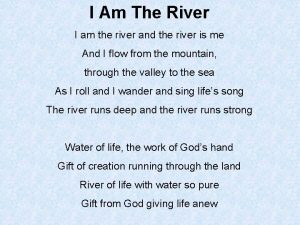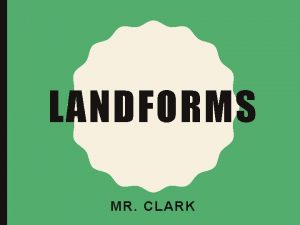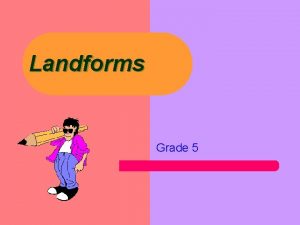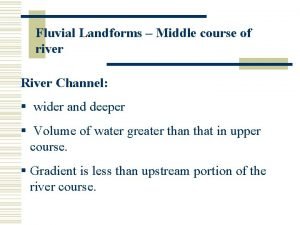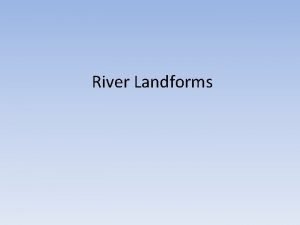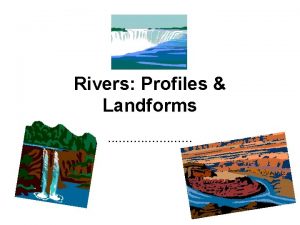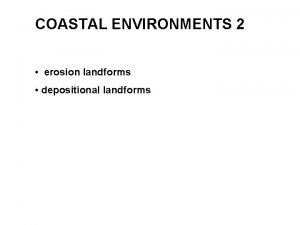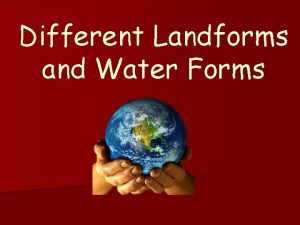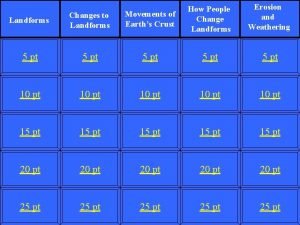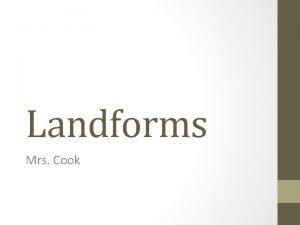River landforms a case study of the River



















- Slides: 19

River landforms: a case study of the River Severn

Getting started You’ll need a notepad on which to make notes as you go along, or you could make notes, paste images, etc. on your device. You can view these slides: • as a slide-show for the animations and to follow links • in ‘normal’ view if you want to add call-outs or extra slides to make notes, paste images, answer questions. The geo-location of each photo is given using the What 3 Words website. Use this website to see an aerial view of each location. In many locations you can also take a virtual fieldtrip by dragging Pegman onto the map to open Street View. © Geographical Association, 2021

The source of the River Severn The River Severn (Afon Hafren) is 354 km (220 miles) long, making it the UK’s longest river. The source of the River Severn is on the slopes of Plynlimon in mid-Wales at about 600 metres above sea level. The hills in this part of Wales receive about 2, 650 mm of rainfall each year. By contrast, Cambridge, in eastern England, receives only about 560 mm of rainfall. The rain which falls on Plynlimon soaks into thick layers of peat where it is stored and slowly released into the River Severn. Activities Use the search engine Bing, click on maps and search for Hafren Forest. Select the Ordnance Survey map. The source of the River Severn is a little to the west of the location where the map opens. You may want to zoom out a little to find it. 1. What is the OS four figure grid reference for the source of the River Severn? 2. In which direction does the river flow for the first five kilometres? 3. Describe the contour lines in grid square 8388. What does this tell you? 4. Describe two main land uses in this area. You can toggle to aerial view to help with this activity. © Geographical Association, 2021

Rapids For the first few kilometres the River Severn flows across alternating layers of sandstone, mudstone and siltstone. The river uses abrasion and hydraulic action to erode vertically downwards into its bed. The sandstone is more resistant to erosion than the beds of mudstone and siltstone so the river has formed rapids (or cascades) as it flows. In this photo, just downstream of the rapids, you can see alternating bands of sedimentary rock on the river bed. You can also see some rounded boulders that have been eroded from the rapids. © Geographical Association, 2021 Video of rapids on the River Severn Geo-location: vintages. finishes. robot

Confluence For the first kilometre, the River Severn is just a narrow stream. It flows across open moorland then enters Hafren Forest which is largely planted with coniferous trees. Several small tributaries join the River Severn so, 5 km from its source, the river is about 5 or 6 metres wide. This photo shows the confluence of the River Severn and one of its tributaries, the Nant Maesnant. t an n s ae t. M n Na The confluence is the place where a tributary joins another river River Severn Geo-location: valid. remarked. overlaid © Geographical Association, 2021

V-shaped valley The confluence with the Nant Maesant is 320 m above sea level. From this confluence the River Severn flows for about 9 km towards the town of Llanidloes which is 170 m above sea level. In this section of the river, it has used vertical erosion to cut a V-shaped valley with inter-locking spurs. Activity Calculate the gradient of the River Severn between its confluence with the Nant Maesnant and Llanidloes. Express this as metres (height) per kilometre (length). A V-shaped valley is formed by vertical erosion. A V-shaped valley has interlocking spurs that look like the teeth of a zip when viewed from above. They are formed as the river swings from side to side. Geo-location: lows. crush. slopes © Geographical Association, 2021

Water-break-its-neck waterfall About 6 km from its source, the River Severn plunges over a narrow band of sandstone in a waterfall called Water-break-itsneck (Hafren-Torri-Gwddf). You can see thick beds of sandstone here, to the side of the waterfall. Geo-location: burglars. freshest. save © Geographical Association, 2021

Water break its neck These photos show the waterfall. On the left the camera is pointing upstream. You can see the resistant layers of sandstone at the top of the waterfall and the plunge pool below. Geo-location: burglars. freshest. save The plunge pool is the deep section of river channel at the base of the waterfall. © Geographical Association, 2021 The gorge is the narrow, steepsided river valley below the waterfall. It is formed as the waterfall retreats. The photo on the right shows the gorge that has developed downstream of the waterfall.

How do waterfalls form? Activity Drag the labels to the correct positions on the diagram so they match the labels below: A – Abrasion erodes the plunge pool B – Beds of mudstone that are less resistant to erosion C – Sandstone that is resistant to erosion D – The base of the mudstone cliff is eroded by hydraulic action and solution E – Overhang that will eventually collapse causing the waterfall to retreat upstream F – The load is worn down by attrition as it is carried downstream © Geographical Association, 2021 A B C D E F

A – Abrasion erodes the plunge pool B – Beds of mudstone that are less resistant to erosion C – Sandstone that is resistant to erosion D – The base of the mudstone cliff is eroded by hydraulic action and solution E – Overhang that will eventually collapse causing the waterfall to retreat upstream. F – The load is worn down by attrition as it is carried downstream © Geographical Association, 2021 The finished diagram should look like this. C E B F D A

The middle course of the River Severn After Llanidloes the gradient of the River Severn is much flatter. The river flows east and north east through mid. Wales past Newtown and Welshpool and then into Shropshire where it flows through Shrewsbury and Ironbridge. This flat area of grassland is a floodplain. Water spills across this field when the river is in flood. Flood water deposits sediment so the floodplain has been gradually formed over hundreds of floods. Look carefully at the river bank. The river is eroding a small cliff using lateral erosion. You can see layers of silt that have been deposited by the river in the past when it spilled onto the floodplain © Geographical Association, 2021 The River Severn, Powys, near Newtown Geo-location: technical. restriction. insurers

Meanders are sweeping curves in the river channel. There a large number of meanders along the middle and lower course of the River Severn. Meanders are formed by lateral erosion on the outside bend of each meander and deposition on the inside of each bend. Meanders are constantly changing shape because of the © Geographical Association, 2021 processes of erosion You can see the river cliff on the outside bank of this large meander. Hydraulic action and abrasion cause lateral erosion here where the river is flowing fastest within the river channel. You can see a river beach – known as a point bar or slip-off slope on the inside bend of this large meander. The river is flowing with less energy here and friction is greater, so the river deposits load. Meander on the River Severn, Shropshire Geo-location: sprinkle. game. imparting

Ox-bow lakes are horseshoe shaped ponds that can sometimes be found on the floodplain close to a meandering river. They are formed by lateral erosion – when a river erodes a new channel through the floodplain to cut off an old meandering loop. River Severn at Dolydd Hafren, Powys Geo-location: soonest. boxing. frocks Activities Use the search engine Bing, click on maps and search for Berriew. The River Severn is about 1. 5 km to the east of the village of Berriew so you may need to zoom out a little. Select the Ordnance Survey map. 1. Describe what you can see in grid square 2000. 2. Switch to the aerial view. Suggest why some of the ox-bow lakes that are shown on the map are difficult to see on the aerial view. © Geographical Association, 2021

The lower course of the River Severn An estuary is the mouth of a river where fresh water meets sea water. The height of the water in an estuary goes up and down with the tide. The River Severn, near Rodley, Gloucestershire Geo-location: stems. outer. palace © Geographical Association, 2021 For the final few kilometres of the River Severn the river is very wide. It flows across a flat landscape into the Bristol Channel where it forms an estuary. In this photo you can see that the river is transporting a lot of silt in suspension. It has also deposited enormous banks of sand silt. Activity Use What 3 Words and select satellite view. You will need to zoom out a bit. Follow the river downstream as far as the M 4 bridge. Describe the shape, width and colour of the river. What does this tell you about the processes that are occurring in the river here?

The River Severn We have seen how the River Severn changes as the river flows downstream. These downstream changes are typical of most rivers in the UK. © Geographical Association, 2021 Activities Use What 3 Words website and select the satellite view. Visit each of the following locations, starting near the source of the River Severn and moving downstream. a) Describe the river and the surrounding landscape at each location. Think about the shape of the river, its width, the gradient, and the width of the valley or floodplain. • raced. concerned. stacks • snoozing. reduction. sounding • crops. songbook. changing • gross. fills. pest • gangs. neck. loser • guru. bank. costumed b) Write a 200 word report that describes how the river changes as it flows downstream.

Glossary: erosional processes Hydraulic action Attrition Hydraulic action Solution Abrasion © Geographical Association, 2021 Abrasion Solution Attrition Stones in the river channel are thrown against each other and they are worn away, becoming smaller and smoother. Fast-flowing water forces air and water into cracks and fissures in the river bank and river bed. Minerals in the rocks of the river channel, such as calcium carbonate, are dissolved in the river water. Fast-flowing water throws stones against the river bank and river bed, causing the bank and bed to be worn away.

Glossary: transportation processes Traction Suspension Saltation Solution Suspension The smallest particles hang in the water and are carried long distances even in slow moving water. Saltation Sand skips and bounces along in fast moving water. Solution Minerals, which have been dissolved, are carried along in the river water. Traction The largest stones (known as the bed load) roll along the river bed. © Geographical Association, 2021

Links From the awarding bodies Topic AQA 3. 1. 3. 2, 3. 1. 3. 3, 3. 1. 3. 4 Coastal, river, glacial landscapes Edexcel A 1: The changing landscape of the UK Edexcel B 4: The UK’s evolving physical landscape Eduqas A 1: Landscapes and physical processes Eduqas B 2. 1: Shaping the landscape OCR A 1. 1 Landscapes of the UK OCR B 3 Distinctive landscapes WJEC 1: Landscapes and physical processes CCEA 3. 4, 1 A: River environments. © Geographical Association, 2021 Find out more • A video that explains the formation of a waterfall and gorge • There is a GEO Power. Point on ‘River processes’ and one on.

Acknowledgements This presentation has been written by Andy Owen, author and Consultant to the GA Figures • Slides 4, 5, 6, 7, 8, 11 and 12: photos and video © Andy Owen • Slide 13: photo © Jeremy Bolwell • Slide 14: photo © Derek Harper © Geographical Association, 2021
 River eden case study
River eden case study Forked river brewing company case study
Forked river brewing company case study Best worst and average case
Best worst and average case Fbi virtual case file case study
Fbi virtual case file case study Green river watershed
Green river watershed I am the river and the river is me
I am the river and the river is me Hát kết hợp bộ gõ cơ thể
Hát kết hợp bộ gõ cơ thể Ng-html
Ng-html Bổ thể
Bổ thể Tỉ lệ cơ thể trẻ em
Tỉ lệ cơ thể trẻ em Voi kéo gỗ như thế nào
Voi kéo gỗ như thế nào Thang điểm glasgow
Thang điểm glasgow Chúa yêu trần thế
Chúa yêu trần thế Môn thể thao bắt đầu bằng chữ f
Môn thể thao bắt đầu bằng chữ f Thế nào là hệ số cao nhất
Thế nào là hệ số cao nhất Các châu lục và đại dương trên thế giới
Các châu lục và đại dương trên thế giới Cong thức tính động năng
Cong thức tính động năng Trời xanh đây là của chúng ta thể thơ
Trời xanh đây là của chúng ta thể thơ Mật thư tọa độ 5x5
Mật thư tọa độ 5x5 Làm thế nào để 102-1=99
Làm thế nào để 102-1=99

